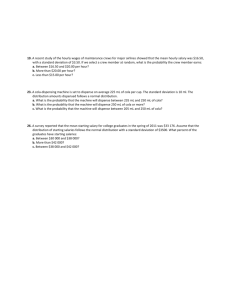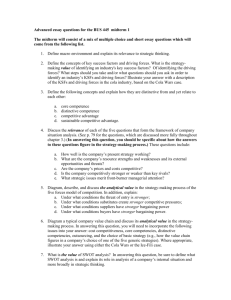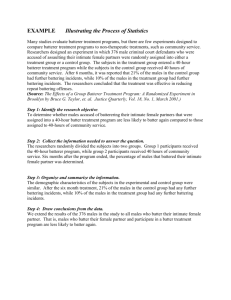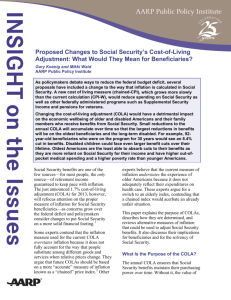ss_keeping_funded
advertisement
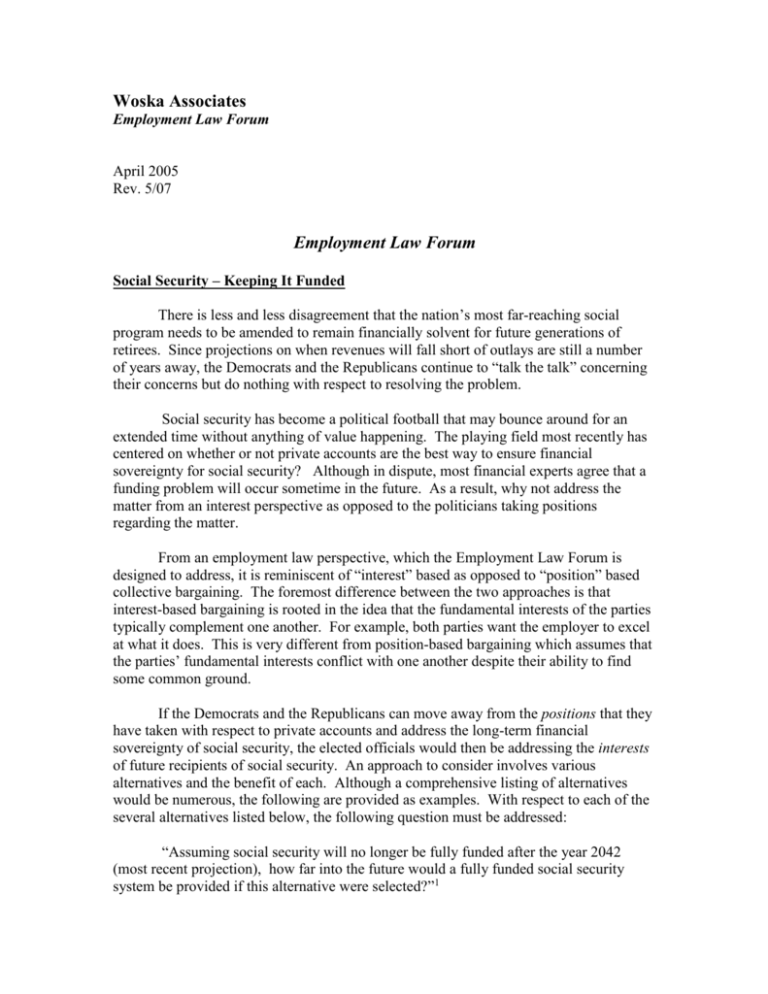
Woska Associates Employment Law Forum April 2005 Rev. 5/07 Employment Law Forum Social Security – Keeping It Funded There is less and less disagreement that the nation’s most far-reaching social program needs to be amended to remain financially solvent for future generations of retirees. Since projections on when revenues will fall short of outlays are still a number of years away, the Democrats and the Republicans continue to “talk the talk” concerning their concerns but do nothing with respect to resolving the problem. Social security has become a political football that may bounce around for an extended time without anything of value happening. The playing field most recently has centered on whether or not private accounts are the best way to ensure financial sovereignty for social security? Although in dispute, most financial experts agree that a funding problem will occur sometime in the future. As a result, why not address the matter from an interest perspective as opposed to the politicians taking positions regarding the matter. From an employment law perspective, which the Employment Law Forum is designed to address, it is reminiscent of “interest” based as opposed to “position” based collective bargaining. The foremost difference between the two approaches is that interest-based bargaining is rooted in the idea that the fundamental interests of the parties typically complement one another. For example, both parties want the employer to excel at what it does. This is very different from position-based bargaining which assumes that the parties’ fundamental interests conflict with one another despite their ability to find some common ground. If the Democrats and the Republicans can move away from the positions that they have taken with respect to private accounts and address the long-term financial sovereignty of social security, the elected officials would then be addressing the interests of future recipients of social security. An approach to consider involves various alternatives and the benefit of each. Although a comprehensive listing of alternatives would be numerous, the following are provided as examples. With respect to each of the several alternatives listed below, the following question must be addressed: “Assuming social security will no longer be fully funded after the year 2042 (most recent projection), how far into the future would a fully funded social security system be provided if this alternative were selected?”1 Alternatives to Consider: 1. Increase the social security tax. Social security is presently withheld on the first $97,500 of annual wages . The maximum earnings are adjusted annually in relation to the gain in average wages. The social security tax is presently 12.4% divided evenly between the employee and the employer. Increasing the social security tax by any amount will significantly impact the funding of social security. For example, increasing the social security tax by one percent to 13.4% is projected to cut the revenue gap in half. 2. Increase age requirements. The age requirement to receive maximum social security benefits was adjusted with the 1983 Social Security Amendments. Until 2003 the maximum age to receive full social security benefits was 65. The age required for the maximum benefit will incrementally increase to 67 in 2007 under the 1983 amendments.2 There are many alternatives that may be considered. Each of the following would have a significant impact on social security funding: a. Increase the age requirement to become eligible for social security benefits. b. Adjust the age requirement for social security eligibility consistent with life expectancy tables. For example, the average life expectancy in the United States increased from 77.3 years to 77.6 years between 2002 and 2003. If age eligibility requirements are adjusted consistent with life expectancy, the social security minimum and maximum benefits would be automatically increased by threetenths (.3)of a year based on the 2002-2003 experience.3 3. Establish a maximum cost of living adjustment (COLA) for social security recipients. Social security recipients have their benefit adjusted annually consistent with the Consumer Price Index for Urban Wage Earners and Clerical Workers (CPI-W).4 Adjustments have ranged from 1.3% to 14.3% since the COLA was implemented in 1975.5 The following are examples of amendments that may be considered: a. Establish a maximum annual COLA (e.g. 4.0%). If the COLA is less than the maximum, the recipient would receive the lesser. If the COLA is greater than, the recipient would receive only the established maximum. b. Establish a maximum annual COLA (e.g. 4.0%). If the COLA is greater than the maximum, although the recipient would be limited to the maximum, the amount in excess would be placed in a reserve to be used in a year when the COLA was less than the maximum. For example, if the annual COLA were 5.0%, recipients would be limited to 4.0% with 1.0% placed in a reserve. If the COLA for the following year was 3.5%, one half of one percent (.5%) would be taken from the reserve to increase the COLA to the 4.0% maximum.6 4. Amend the formula used to determine the social security benefit. The social security benefit is based on an individual’s highest 35 years of earnings. Those wages are indexed so that all 35 have the purchasing power of the year when the person retires. The individual’s Average Indexed Monthly Earnings (AIME), or average monthly salary, is calculated using the 35 years of indexed earnings.7 They do not have to be consecutive years. If the individual has an earnings record for more than 35 years, only the 35 years of highest earnings are included in the calculation. If an individual did not work for a full 35 years, the missing years are counted as zeros. Finally, the AIME is entered into a three-part formula to determine the social security benefit. If the AIME were increased by one month, what would the impact be on a fully funded social security system? Two months, three months, one year? The bottom line is that the average indexed monthly earnings would be reduced. The reduction would have a negligible impact on the person applying for a social security benefit. At the same time, it may have a significant affect on the funding issue. 5. Invest a part of the social security trust fund in securities. Social security revenues that are not needed to pay current benefits are presently invested in low-interest government bonds. Investing in indexed funds could earn higher interest improving the long-term outlook with respect to financial solvency. Investing in indexed funds is low risk and is used widely by public sector pension programs such as the California Public Employees’ Retirement Program and similar programs throughout the country. Conclusion The social security funding issue is too important to become a win/lose issue between the political parties. The several alternatives provided are not intended to be complicated. They are the type of changes that people can generally understand. Any combination of alternatives, simple and complex, may be designed. The goal with respect to amending social security is to provide an on-going, financially solvent program - a program that does not require Congress to again face the funding issue in the future. It is therefore critical that the Democrats and Republicans address the issue in the interests of current and future social security recipients and make it a win/win situation. If the parties agree that social security funding may be an issue in the future, but continue to take positions (e.g. the benefit of private accounts) and social security remains unchanged, it becomes a lose/lose proposition for the American people. 1 Social Security Board of Trustees established 2042 as the date social security would no longer be fully funded. 2 42 U.S.C. 416 (l)(1). 3 Center for Disease Control and Prevention. 4 1972 Social Security Amendments. 5 Social Security Administration. 6 Social Security Administration – the average COLA since 1985 is 2.92%. 7 Annual earnings are limited to maximum wages subject to Social Security tax.

